Types of Locust Trees with Identification Guide and Pictures
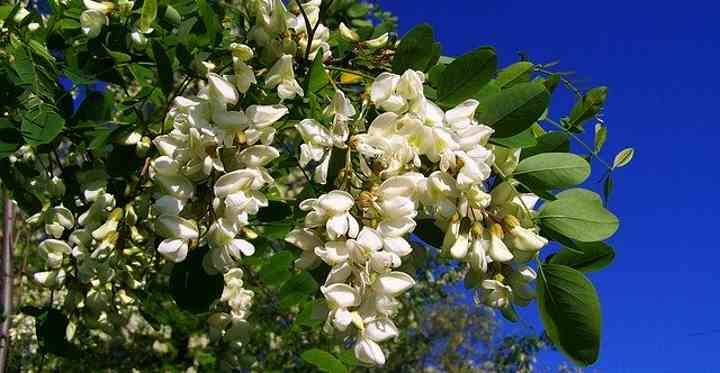
Locust trees are fast-growing flowering trees that belong to a family of flowering plants called Fabaceae. The most common types of locust trees are the black locust and honey locust tree. Locust trees are hardy trees that are known for their hard and durable wood, fragrant sweet spring flowers, and colorful fall foliage. Many varieties of locust trees have long sharp thorns and there are a few thornless species.
Locust trees can live for over a hundred years, and the wood is one of the hardest woods from any deciduous tree. Locust tree lumber is exceptionally durable and the timber is excellent for making furniture, fence posts, flooring, and small boats. Compared to honey locust timber, black locust wood is more common.
Most types of locust trees grow in the eastern states of North America.
The species of locust trees are divided into two genera: Robinia and Gleditsia. Black locust trees are in the Robinia genus, while honey locust trees are in the Gleditsia genus.
The name “honey” comes from the fact that honey locust trees have pods with sweet taste. The sweet-smelling flowers are also a source of nectar for honey bees.
It is important to identify species of locust trees as some varieties are toxic. For example, the black locust tree contains toxic compounds while the pods from the honey locust tree are edible. (1)
In this article, you will learn about the different types of locust trees. Pictures, descriptions, and their scientific names will help identify each species of these deciduous trees.
Locust Tree Identification
Identifying species of locust trees can be done by features such as their flowers, color of bark, height of the tree, and the thorns. Another way to identify the type of locust tree is by the shape and color of its seed pods.
Locust trees grow to between 66 and 98 ft. (20 – 30 m).
The leaves on locust trees are feather-like and pinnately shaped and measure 6” to 14” (15 – 36 cm). The tree leaves have dark-green or light green color, depending on the species. In the fall, the green leaves turn to a stunning bright yellow color. The leaflets are 0.6” to 1” (1.5 – 2.5 cm) and are arranged alternately on the leaf stem. The tree leaves are bipinnately compound meaning that smaller leaf branches grow off the main leaf stem.
Looking at pictures of locust tree leaves, you will notice they are similar to fern leaves.
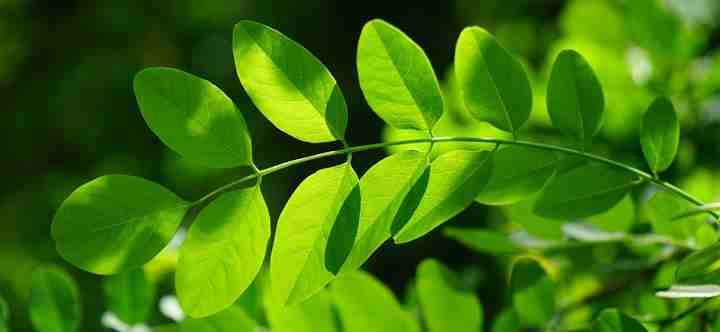
Leaves of black locust tree
Another identifying feature of locust trees is their sharp thorns that can measure 1.2” to 4” (3 – 10 cm) long. These prickly spikes can grow singularly or on thorned branches. They are extremely tough and can easily puncture the skin.
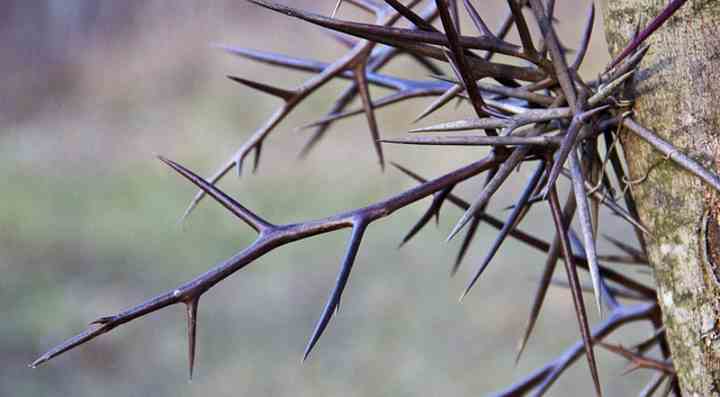
Locust tree thorns
Although native to North America, locust trees grow in many countries throughout the world. These trees grow so fast that, in some regions, they are in the class of an invasive plant species.
Types of Locust Trees (With Pictures): Identification Guide
Let’s look at various kinds of locust trees, starting with the two most popular species—the black locust tree and the honey locust tree.
Black Locust Tree (Robinia pseudoacacia)
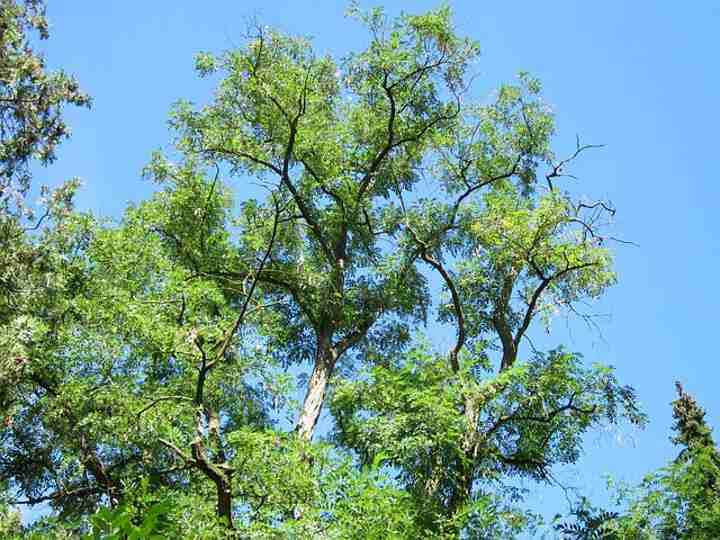
In the picture: black locust tree
The black locust is a deciduous, hard-wooded tree that grows well in sunny locations. Similar to the honey locust, the black locust tree can withstand poor soil, drought, and damp growing environments.
The black locust tree is also called “False Acacia,” “Fragrant White Locust,” and “Common Robinia.” It is native to states such as Pennsylvania, Alabama, Georgia, Missouri, and southern Ohio.
Black locust trees grow to between 40 and 100 ft. (12 – 30 m) with exceptional varieties reaching heights of 171 ft. (52 m). The sharp spines on black locusts are usually present on immature trees and grow at the base of each leaf. Different to honey locust trees, the sharp spikes are short and don’t grow in long branches around the tree.
The bark, seed pods, branches, and leaves are considered to be toxic.
Black locust tree flowers
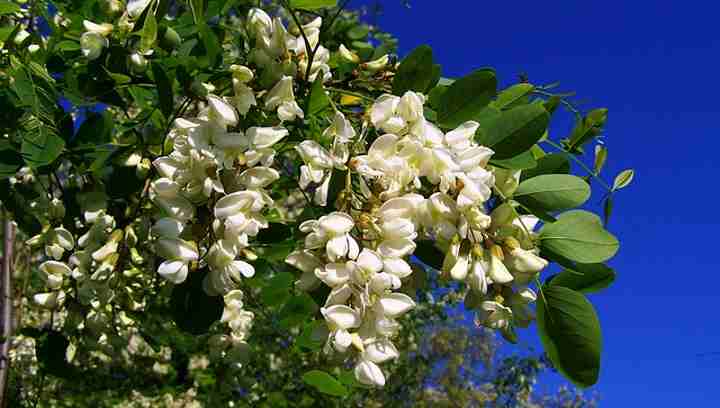
Black locust trees bloom in late spring with intensely fragrant white flowers. Some species produce pink or purple flowers. The flower color helps to tell black locusts apart from honey locust trees that have creamy-green colored flowers.
The large drooping flowers can measure between 4” and 8” (10 – 20 cm) and form attractive clusters. The black locust tree flowers are rich in nectar, making this a beautiful honey plant.
Black locust tree leaves
The leaves on black locust trees are pinnately compound and grow to about 10” (25 cm) long. The small oval or ovoid leaflets on each leaf are about the size of your thumbprint. Compared to honey locust trees, black locust tree leaves are a darker green color.
Black locust tree bark
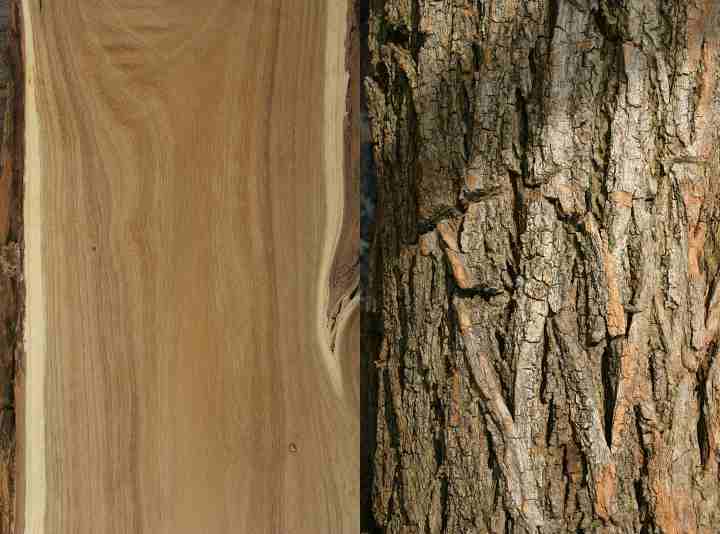
Black locust timber (left) and bark (right)
The bark is deeply furrowed and is brown and gray. Due to orangey-red colors in the deep grooves, the bark may have an overall reddish appearance. The black locust tree bark is not sharp and thorny like the honey locust tree.
Honey Locust Tree (Gleditsia triacanthos)
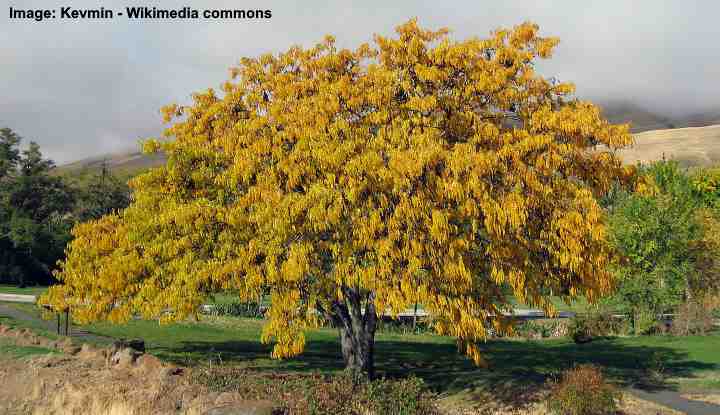
Honey locust tree
The honey locust tree is a hardy, fast-growing tree, similar to the black locust tree. Just like the black locust, the species of honey locust grows in many different environments and thrives in full sun.
Similar to the black locust tree, this genus is native to states such as Pennsylvania, Iowa, Texas, and Georgia.
Honey locust trees grow to between 66 and 100 ft. (20 – 30 m) tall. Unlike the black locust, the honey locust tree trunk has thorny branches growing around it. The sharp barbs usually grow to 4” (10 cm) long, but they can be up to 8” (20 cm). The spiky trunk is one reason why the tree is also called the “thorny” locust.
In a garden landscape, honey locust trees are grown as specimen trees for their ornamental beauty. Bright green foliage turns a beautiful yellow color in the fall. The vast spread of the tree’s foliage, small leaves, and widely-spaced branches make this an excellent shade tree.
Species of honey locust trees with the botanical term “inermis”—a Latin word meaning “harmless” or “defenseless”—in the name are thornless varieties of the species.
Seed pods, or legumes, mature in early fall. These are sweet-tasting peas that animals enjoy eating.
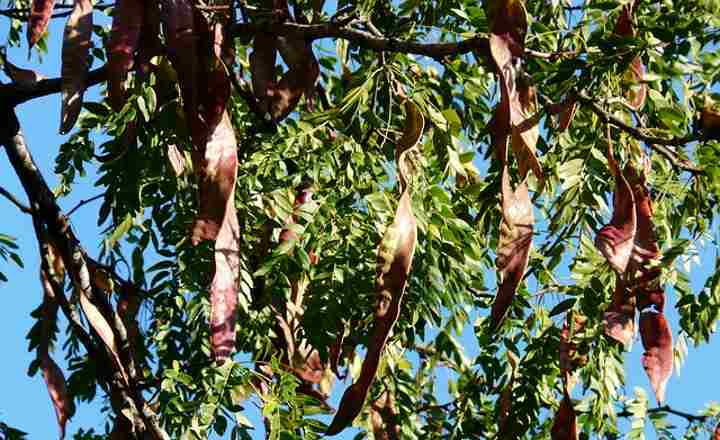
Honey locust seed pods
Honey locust tree flowers

The honey locust has clusters of small, creamy-green flowers that bloom in late spring and early summer. Compared to the black locust, the honey locust tree’s flowers aren’t as showy and stunning. However, both the Robinia and Gleditsia species of locust trees have strongly scented blossoms.
Honey locust tree leaves

The leaves on honey locust trees appear slightly earlier than on black locust trees. One way to tell honey locusts apart from black locust trees is that the leaves have no leaflet at the tip. Also, honey locust tree leaves tend to be a lighter shade of green than the “black” variety.
Honey locust tree bark
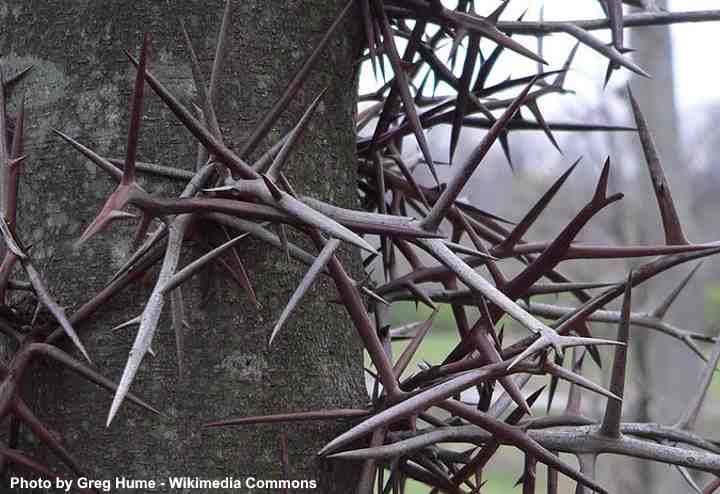
Honey locust tree bark is gray-brown to red-brown and is covered in clumps of branched thorns.
Imperial Honey Locust Tree (Gleditsia triacanthos f. inermis ‘Impcole’)
The imperial honey locust tree is a thornless species of deciduous tree that grows up to 40 ft. (12 m). The fact that this locust tree has no thorns and a wide-spreading canopy means it is a great shade tree for your garden.
Similar to other types of locust trees, the imperial honey locust has beautiful fern-like foliage that turns to sunny yellow in the fall. The trees are also resistant to saline conditions, lack of water, and high winds.
Imperial honey locust tree flowers
The flowers are small clusters of greenish-white florets that bloom in late spring and early summer.
Imperial honey locust tree leaves
The feather-like leaves are pinnately compound that are bright green throughout spring and summer before turning to golden yellow in the fall.
Imperial honey locust tree bark
Like many types of honey locust trees, the bark is gray-brown.
Skyline Honey Locust Tree (Gleditsia triacanthos ‘Skycole’)
The honey locust ‘Skycole’ cultivar is another popular shade tree for garden landscapes. The tree grows to 45 ft. (13 m) and has a canopy spread of 35 ft. (10 m). The fern-like leaves and widely spaced branches give enough shade without completely blocking out sunlight.
One of the reasons this locust tree variety is popular is that it grows in several unfavorable conditions. It can withstand high heat, full sun, acidic or alkaline soil, and urban pollution.
Skyline honey locust tree flowers
Greenish-white, inconspicuous flowers appear in May and June and turn into long twisted seedpods that are a purple color. These pods contain a sweet, honey-like substance as with all honey locust trees.
Skyline honey locust tree leaves
Leaves on the skyline honey locust tree are pinnate or bipinnate containing pairs of small, ovate leaflets. Dark green leaves in the summer turn in to attractive yellow foliage in fall.
Skyline honey locust tree bark
As with most types of honey locust trees, the ‘skyline’ has a spiky trunk with thorned branches. If you want a thornless variety of skyline locust tree, look for the Gleditsia triacanthos f. inermis ‘Skycole’ cultivar.
New Mexico Locust Tree (Robinia neomexicana)
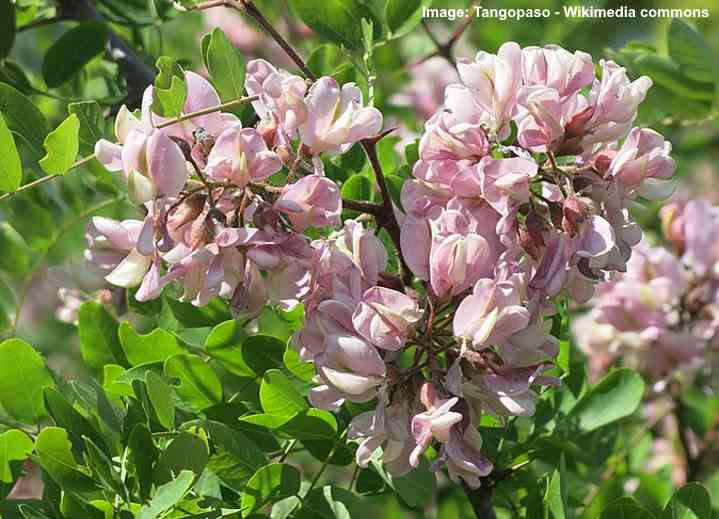
The New Mexico locust tree is also called the southwestern locust or hojalito. This type of ‘black’ locust tree thrives in states such as Colorado, Utah, Arizona, and New Mexico.
Other names for the New Mexico Locust tree include Desert Locust, Pink Locust, or Rose Locust tree.
The New Mexico locust tree grows to between 16 and 32 ft. (5 – 10 m). Late spring and early summer bring out the beautiful fragrant purple-pink clusters of flowers on this locust tree. These attractive blooms attract honey bees who are looking for nectar. These showy flowers grow on reddish-purple branches that have spikes at their base.
New Mexico Honey Locust tree flowers
The sweet-smelling, fragrant flowers are light purple and shades of pink. This flower color is unusual for trees in the genus Robinia as the flowers are commonly white. For this reason, New Mexico honey locust trees are popular for garden landscapes in hot climates.
The flowers turn into brown pods with bristles.
New Mexico Honey Locust tree leaves
Leaves are between 4” and 6” (10 – 15 cm) long and are fern-like similar to all trees in the Robinia and Gleditsia genera. Small hairs or bristles growing on the dark green leaves give them a grayish appearance.
New Mexico Honey Locust tree bark
Similar to the black honey locust tree, the bark on the New Mexico cultivar is light gray-brown with shallow furrows.
Sunburst Honey Locust Tree (Gleditsia triacanthos var. inermis ‘Suncole’)
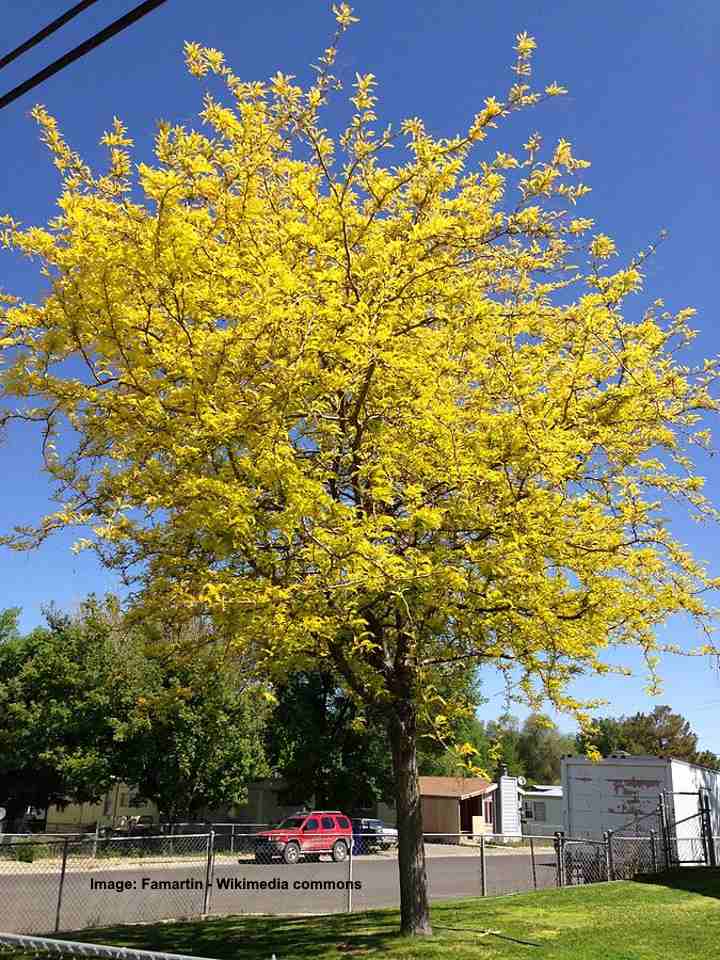
The locust tree ‘Suncole’ cultivar is a popular deciduous tree because of its feathery foliage that provides dappled shade in the hot sun. This variety has the term ‘inermis’ which means that the Sunburst honey locust is a thornless tree.
Compared to the native honey locust species, the Sunburst cultivar is shorter. Rather than growing to 80 or 100 ft. (24 – 30 m), the sunburst honey locust only reaches 40 ft. (12 m) in height.
There are many reasons why the ‘Suncole’ cultivar is popular in landscape gardens. Its wide spread, lack of thorns, and pod-less characteristics mean it is not a ‘messy’ tree. There are no sharp spine or pods to clear up in the fall.
Sunburst Honey Locust tree flowers
The small flower clusters are a greenish-yellow color that provide color to your garden in late spring and early summer.
Sunburst Honey Locust tree leaves
Sunburst locust leaves are pinnate and have a fine texture. New leaf growth in spring is a pale-yellow color that gradually turns to light green in summer. In fall, the fern-like foliage turns a beautiful yellow color, similar to all types of locust trees.
Thornless Honey Locust Tree (Gleditsia triacanthos f. inermis)
Choose a thornless variety of honey locust trees if you want to grow an elegant, tall honey locust in your garden.
Thornless locust trees have beautiful foliage, bright flowers, and attract honey bees. Because the ‘inermis’ cultivars have no sharp spikes on the bark, there is no danger of injuring yourself.
There are several cultivars of thornless honey locust trees, such as Imperial (‘Impcole’), Skyline (‘Skycole’), Sunburst (‘suncole’), Moraine, Northern Acclaim (‘Harve’), Perfection (‘Wandell’) and Street Keeper (‘Draves’).
Purple Robe Locust Tree (Robinia pseudoacacia ‘Purple Robe’)

The attractive features of the ‘Purple Robe’ locust tree are its young red leaves that turn to blue-green and then turn yellow in fall. Similar to other cultivated honey locust trees, the ‘Purple Robe’ grows to between 30 and 40 ft. (9 – 12 m) tall and has a spread of up to 30 ft. (9 m) wide.
The feather fern foliage and branches that are spaced widely apart mean that this locust tree is another excellent tree to provide shade in a backyard or garden landscape. As with all types of locust trees, such as the black locust and honey locust, this is a cold-hardy, drought-resistant type of tree.
Purple Robe Locust tree flowers
Clusters of heavily scented pink-purple flowers dangle from the locust tree, filling your garden with spring colors.
Purple Robe Locust tree leaves
The ‘Purple Robe’ locust tree’s leaves are metallic red when immature, and they gradually turn a deep green or bluish-green color.
Bristly Locust Tree (Robinia hispida)
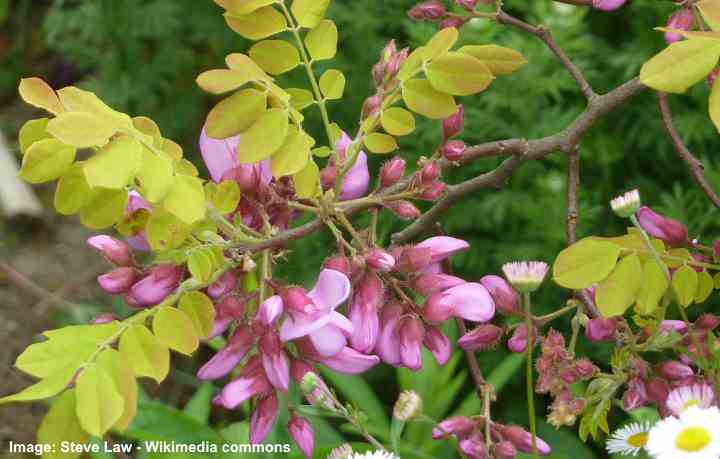
The bristly locust tree is a large flowering shrub with compound leaves, pink pea-like scented flowers, and reddish-brown seed pods. Its fast-growing nature and intricate root system mean that the bristly locust shrubby tree is considered invasive in many states.
Other names for the bristly locust tree include rose-acacia and moss locust.
Because bristly locust plants don’t grow higher than 10 ft. (3 m), they are a perfect type of small tree for your garden. Plant your small bristly locust tree in full sun and well-draining soil. The spread of up to 15 ft. means that the locust shrub is suitable for groundcover in sunny gardens.
Bristly Locust tree flowers
Purple-pink pendulous flowers provide plenty of color to a garden in late spring and early summer. These showy flowers have an intense fragrance meaning the bristly locust tree attracts honey bees and other pollinators.
Bristly Locust tree leaves
Leaves are pinnately compound with between 7 and 15 leaflets on each leaf. Being a member of the Robinia genus, there is a small oval leaflet at the tip of each leaf.
Bristly Locust tree bark
The bark on bristly locust trees is gray and smooth. Young branches have purple-brown colored fine hairs, giving the stalks a bristly appearance.
Shademaster Honey Locust Tree
The shademaster honey locust is the perfect tree if you are looking for a lawn tree. This is a thornless and pod-less variety of locust tree with small leaflets meaning that it is easy to maintain. You also have less work in the fall to clear up shed foliage.
The excellent shade from this locust tree comes from the exceptionally wide canopy coverage. The tree can grow up to 75 ft. (22 m) tall and provide shade up to 40 ft. (12 m) wide. The widely spaced branches and pinnate leaves provide plenty of shade in hot summers. However, the dappled sunlight means that plants that need partial shade grow well in its shadow.
Related articles:
